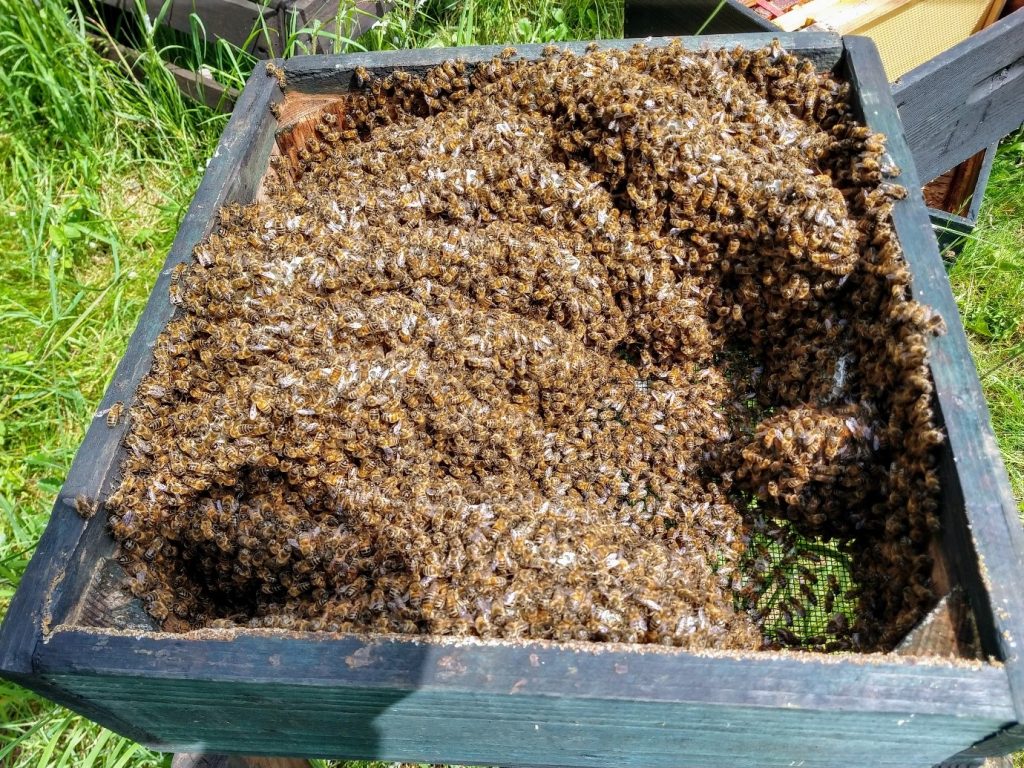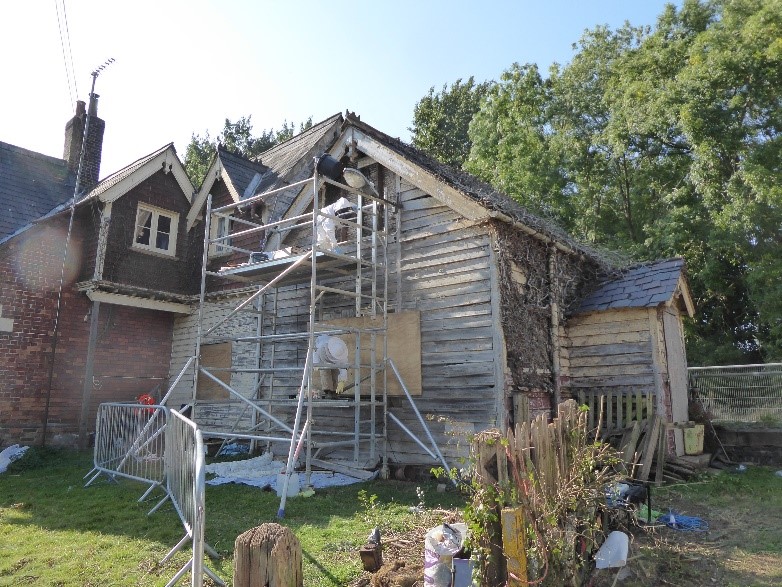An article about one of your beekeeping experiences with the title “What I learnt from my mistake”.
| Entrant ID: | 1043969 | Entrant Name: | Sue Lang |
| Entry: | What I learnt from my beekeeping mistake(s)
Imagine the scene – dusk on a mid summers evening, warm, no wind. Perfect weather for moving bees to the Borage crop. So, what went wrong? The site for the hives was next to a hedge, alongside the borage. It was quite a walk from the main track, so we/he decided to reverse up alongside the hedge and lift the hives out onto their stands. Realising that there were already two hives in place, he had to give them a bit of space. Unfortunately, we/he didn’t check his mirror on the other side and slipped off the edge of the track into the field. As it had recently rained It was slippery, and after a lot of wheel spinning/mud flinging realisation dawned that help was needed to pull the car out. Whilst our mentor phoned the farmer (who was away, but his wife was home and could drive the tractor), we lifted the hives out and put them on the stands. One job done! Farmers wife arrived in the tractor, by this time I’d walked away and undone my beesuit to get a bit of air. She reversed down the same bit of field next to the hedge, but didn’t event see the hives already there. One got knocked over – bees everywhere! He and mentor put that hive right whilst I kept out of the way. The bees weren’t content to stay in the hive though and came to say hello to me – not the best time to get your first sting! Car was attached to the tractor and pulled out OK. What did we learn? We should have started much earlier for more light, we should have just carried the two hives along the hedge, I should have kept my beesuit done up all the time. But it was worth it in the end because of the fabulous quantity/quality of the honey they produced. The End. Or was it? Moving bees to a crop means moving them home afterwards. So, we arrived earlier, strapped the hives up, closed the entrances with foam and tape, and carried them to the car (ha! We learned that lesson!). We lifted the first hive into the car – the design of that car meant we couldn’t have them side by side. There wasn’t enough space to put the second hive behind the first. We should have pulled the hive up by pulling the plastic sheet, but no, we/he pushed the hive. Unfortunately, we/he hadn’t fixed the straps as a cross, so the brood box moved, but the floor didn’t. Bees poured out! Luckily (Ha! another lesson learned), both beesuits were done up so no stings received. All we could do was lift the hive back out and take it back to its site – the bees had beaten us there and were circling round the stand going ‘where’s our house gone?’. 24 hours later the hive was strapped in a cross, sealed and moved safely home – phew! |
||
| Result: |  |
||
| Entrant ID: | 1045317 | Entrant Name: | Wally Thrale |
| Entry: | What I learned from swarm control where the queen has been clipped.
As part of my swarm control regime I mark and clip all queens. Clipping queens does not necessarily mean that swarming is stopped but merely delayed for a few days. It is easy to miss the presence of a queen cell during inspections or if the weather does not allow for a colony to be checked at the next due date for queen cell inspection. So a swarm can emerge between inspections without the knowledge of the beekeeper. When a colony swarms with a clipped queen it flies off to a nearby spot and forms a typical cluster. The clipped queen however, on leaving the hive is not able to fly far at all. Several times I have seen a colony return to the hive in such a situation and located and caged the queen near to the hive. It is then a straight forward matter to carry out an artificial swarm in this situation as the queen is already caged. Normally it is a matter of moving the brood box to another spot after removing a frame of sealed brood to place in the empty brood box. This empty brood box is placed on the original site and some bees shaken in from the parent colony. The queen is then released into the new brood box where there are some bees to look after her. Meanwhile, flying bees from the parent brood box will eventually make their way back to their original location after their next foraging flight. An easy way to artificially swarm a colony. There is one downside to this method which is sometimes the queen will make her way up the hive stand and under the hive floor. The swarm may also join her and then consider this their new home. So as part of my inspection process I always check under the floor to see if bees have settled there. If there is a colony present they can easily be knocked into a spare hive and moved to another apiary. In the picture below the swarm has been there for a while so they would orientate to their original location if left in the same apiary, hence the move to another site. |
||
| Result: |  |
||
| Entrant ID: | 1038006 | Entrant Name: | Colin Hall |
| Entry: | I hate losing bees. Early on, I nearly gave up beekeeping after a winter when half of my hives died out. In old age, I feel ever more passionate about preserving honeybees – well, nearly all living things.
We were using a bee vac to suck up the bees from their home in a chimney that had to be removed. The bee vac is essentially a nuc box to which you attach a vacuum cleaner. Another tube comes out of the box with which you suck up the bees into the box. The Association had purchased one, and it had been trialled on a small swarm spread around the trunk of a tree. Care had been taken to suck up the bees quite gently so as not to injure them, and it worked effectively – if rather slowly. On this new occasion high up on the scaffolding, it was very difficult to reach far down into the chimney and remove the pieces of old dark comb, let alone collect the bees, as the builder, duly kitted up, removed each course of bricks. I should add that a very new beekeeper who lived next door calmly and courageously joined me in the venture. It was very slow, laborious work with the bee vac, in hot weather, with the bees disturbed and flying, but we stuck at it for several hours. Finally, we checked in the bee vac box. Tragedy. Over half of the bees were dead or dying. Why? Suffocation? Overheating? Had the suction been too strong, injuring the bees against the wall of the box? In beekeeping, it is not always easy or even possible to know exactly why things have gone wrong. The bee vac has lain unused – by me, at least.
The nest was super thin, between wooden boarding and a wall. Essentially a very big, old single comb. This time, on a scorching hot day, the bee vac was set on gentle power. It has a ventilation valve on the side of the box, which can reduce the suction while giving the bees some air. We managed between us to catch nearly all the bees with the vac. Afterwards, success – not a bee dead. Even though we had forgotten to use the extra ventilation feature: the bottom part of the box can be removed, so that it becomes a nuc box with an open mesh floor. So what have I learnt? Keep the power and suction fairly low. Gently does it. Consider using the bee vac for rescuing bees in awkward places. |
||
| Result: | – | ||
| Entrant ID: | 1042567 | Entrant Name: | Gill Brewer |
| Entry: | What I learnt from my mistake. In my early days as a beekeeper I was disappointed to find I had a large queenless colony. But that spring I had made up a nucleus, so my plan was to use the nucleus to requeen the colony. It took a couple more weeks but eventually the queen in the nucleus started laying in a beautiful brood pattern. She was huge, I was very pleased with her. I united the nucleus on top of the queenless colony. That turned out to be my mistake. The following week my lovely new queen was gone! There were no eggs or young larvae in the top nucleus box. I searched right through the colony. Only now, on careful examination, did I see the eggs in the bottom brood chamber, and they weren’t in any beautiful pattern; they were haphazard, with multiple eggs in some cells. I spoke to my mentor, who confirmed my suspicions. The colony had laying workers and they had killed my lovely new queen. The colony had been both queenless and broodless for too long. Together queen pheromone and brood pheromone normally supress worker ovary development. But without them, some of my workers had developed ovaries sufficiently to lay eggs. Not as many eggs as a queen can lay, and only unfertilised eggs because workers don’t have the physiology to mate or store sperm. Laying workers also have altered pheromones which mimic the queen pheromone, this was why the bees in the colony, thinking they had a queen, had killed my introduced queen. I spent the rest of the season continuing to learn from my mistake and correcting the situation. One way of dealing with a small colony of laying workers is to move the entire hive about 20m from the apiary, shake out all the bees and remove the hive. Ordinary bees will fly back to the apiary and drift into an adjacent hive. This technique removes the laying workers – maybe they can’t fly, or are poorly orientated and are lost, or they are refused entry due to their altered pheromones – anyhow it works. My colony was too big to shake out the bees and remove the hive. But I used a variation of the shaking out technique to remove the laying workers. I left the supers on the hive stand and took the brood box 20m away and shook out all the bees. The normal bees flew back into the supers, the laying workers were lost. The brood box was then put back in place. Next a couple of combs of open brood were added from another colony to start restoring the normal hive pheromones. Now the colony needed a queen. Not having a spare queen, I put in a frame with a sealed queen cell from a swarming colony. It was another month before the colony was queenright and building up again and they produced very little honey. But I learnt lots about bees and beekeeping from my mistake! |
||
| Result: |  |
||
| Entrant ID: | 1039854 | Entrant Name: | Fiona Cook |
| Entry: | “What I learnt from my mistake…”
It was a warm sunny day with a gentle breeze blowing –good weather for looking at my bees. The previous day I had attended the British Beekeepers Spring Convention at Stoneleigh and picked up some useful leaflets about bee diseases. I opened a colony and started examining the frames. The queen was spotted walking across the second frame. Subsequent frames were taken from the box, the bees brushed off and frames examined. All was looking good – eggs and creamy white round larvae in the brood nest and plenty of stores, both honey and pollen. I got to about the seventh frame and when I brushed off the bees I saw some holes in the brood cappings – this rang alarm bells. The leaflet that I had picked up the previous day had said something about holes in brood cappings being the sign of a serious disease. I thought that the best course of action would be to go back to the house and find the leaflet and read it again. As I did not have a camera with me, I marked the frame with a drawing pin, replaced all the frames and shut the hive. I found the leaflet and it confirmed my fears – holes in cappings can be caused by bees breaking into sealed cells if they knew that the larvae have died. One of the main diseases that causes larvae to die after they have been sealed is American Foul Brood (AFB). I felt awful, not having much experience keeping bees and as AFB is not treated in the UK, I was facing the possible prospect of going to have to destroy one of my colonies. My husband suggested that we should have another look at the frame and try and photograph it. With trepidation we returned to the apiary and carefully removed the marked frame. We examined the frame and compared it with the pictures and details in the leaflet. The cappings were raised and biscuit coloured, as would be expected when you have healthy sealed brood – not the waxy and sunken cappings that you get in AFB infected colonies. But there was no denying that there were holes in the cappings. Then I noticed that there seemed to be movement near one of the holes – so I watched carefully. Something wonderful happened – I saw my first young hairy honey bee emerge! The slab of sealed brood had holes in the cappings because the young bees were emerging and eating their way out of their cells – so I had a healthy colony after all! So what did I learn from my mistake? Well firstly, if in doubt about bee diseases there if help available. This also made me realise that I really needed to learn more about bee diseases, so I accessed some structured learning and ended up completing the British Beekeepers Association Module 3 (honeybee diseases). |
||
| Result: | – | ||


 Then this summer I was invited to join a small team of beekeepers – with a request to bring the bee vac. Our task was to remove a honeybee nest high up in an old railway house next to the Oxford-Cambridge line being re-opened by Network Rail. The building, home also to five different species of bats, was to be demolished.
Then this summer I was invited to join a small team of beekeepers – with a request to bring the bee vac. Our task was to remove a honeybee nest high up in an old railway house next to the Oxford-Cambridge line being re-opened by Network Rail. The building, home also to five different species of bats, was to be demolished.